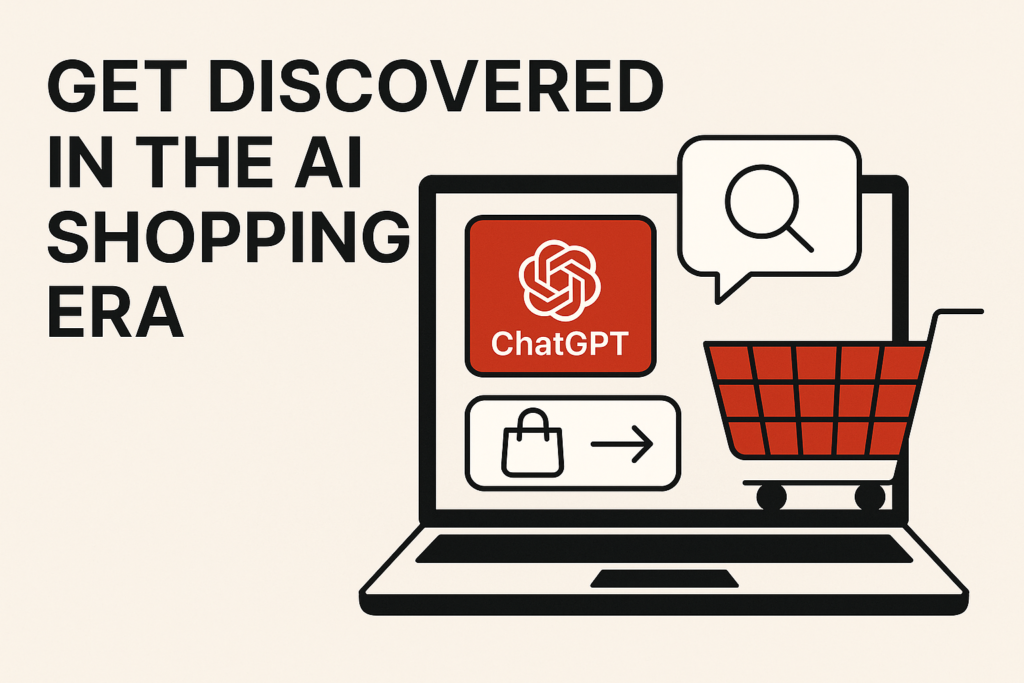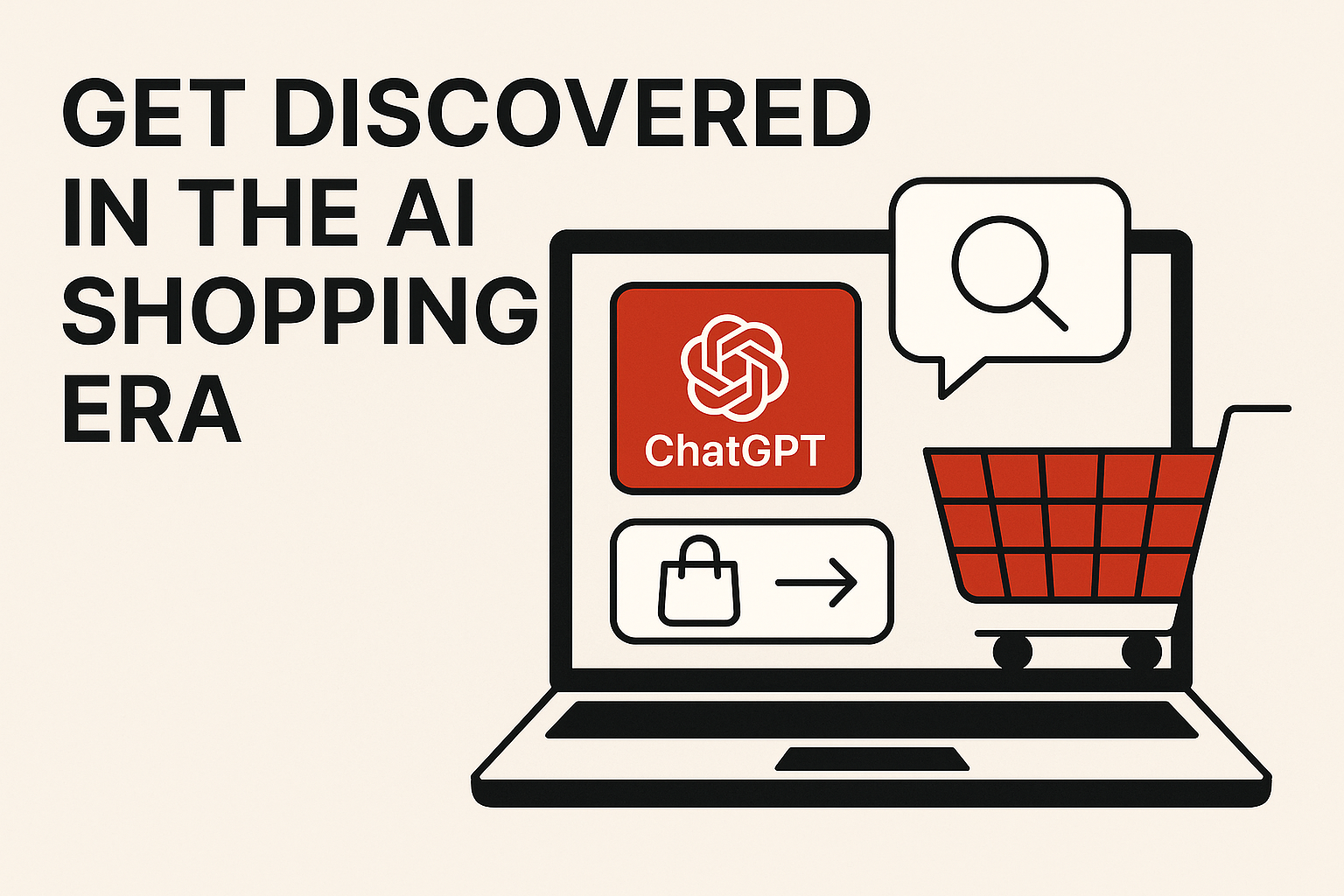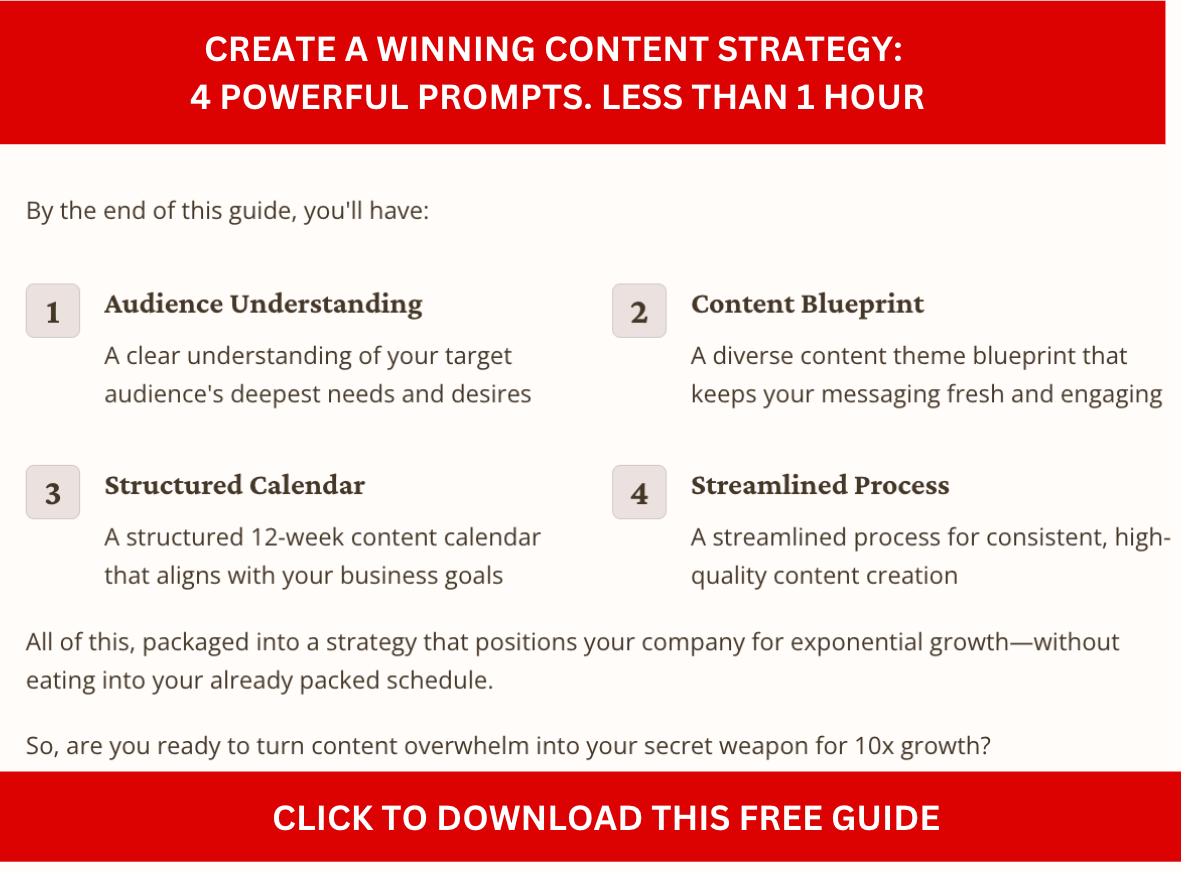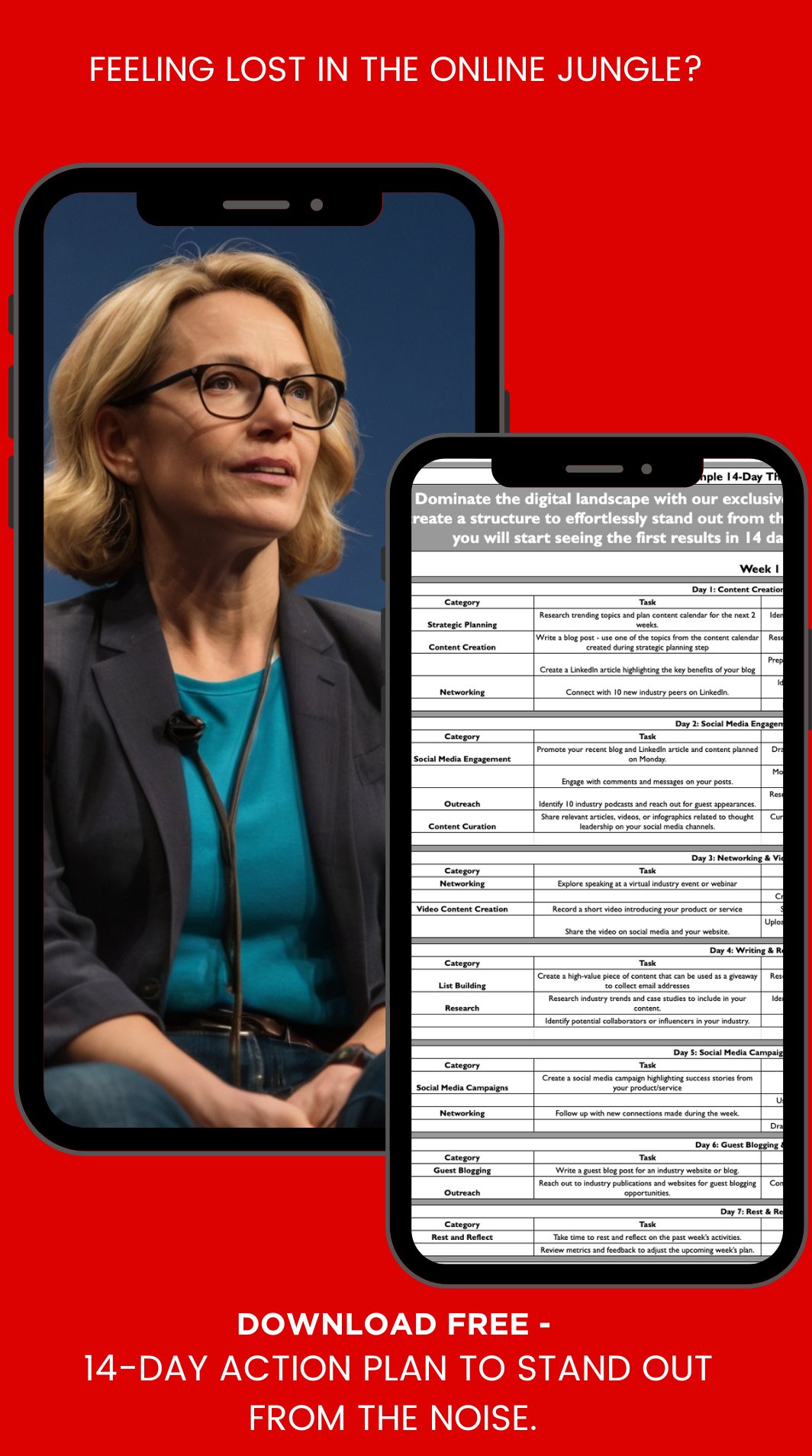While everyone’s eyes are glued to ChatGPT’s new physical product shopping features, there’s a massive shift happening that nobody’s talking about and it directly impacts your digital downloads business.
This isn’t just another AI update. It’s the beginning of a fundamental change in how people discover and buy software, courses, templates and every digital product you’ve worked so hard to create.
Just a few years ago, if you needed a recommendation, answer, or tool, you’d open a browser and Google it.
Today?
Millions are skipping that step entirely.
They’re asking ChatGPT.
From finding the best software for freelancers to discovering top-rated online courses, people are turning to AI platforms like ChatGPT to get fast, direct, and personalized answers — without sifting through endless links.
This shift is huge. And it’s reshaping the way we all discover digital products.
Here’s why it matters to you:
- You’re no longer at the mercy of SEO tricks or paid ads
- Answers come from context, not just keywords
- The best tools are rising to the top based on real usefulness — not clever headlines
That means your next favorite app, course, or template might not show up on page one of Google…
It’ll be the one ChatGPT recommends in a sentence.
So the real question is how to get ranked by ChatGPT shopping.
Let me break down what’s happening, why it matters, and exactly how to position your digital products to win in this new AI-powered shopping landscape — all before your competitors catch on.
Table of Contents
ToggleThe New Reality: AI Is Becoming the Ultimate Shopping Assistant
Instead of typing keywords into a search bar and scanning endless links, users now ask ChatGPT real questions, like:
“What’s a great minimalist home decor setup under $100?”
The AI responds with curated options — including comparisons, pros and cons, reviews, and more. It’s like having a personal product analyst in your pocket.
Users can:
- Compare products side-by-side (features, price, user reviews)
- Discover options from smaller brands, not just big-name retailers
- Get creative recommendations (e.g., gifts based on personality or occasion)
- Interact in real-time to refine their choices — directly in chat
This streamlines the process from discovery to decision in minutes, not days. Right now it is mostly focused on physical products but the digital products are next in line.
The big question: When this happens, will YOUR software or digital product show up as a top recommendation?
For most creators, sadly, the answer is “no” — unless you start preparing now.
Digital Products Are Next in Line (And Here’s Why)
While the current rollout focuses on physical goods, all signs point to digital products being next. Why?
- The technology is category-agnostic. The same NLP and recommendation engines that compare headphones can easily compare software features, course curriculums, or template designs.
- Digital products have structured attributes. Price points, features, compatibility, user ratings — these are perfect for AI comparison.
- Buyer intent is already shifting. People are already asking ChatGPT things like “recommend me a good coding course” or “what’s the best invoicing software?”
The difference between winners and losers in this new landscape won’t be who has the biggest ad budget. It will be who has optimized their digital products for AI discovery.
Two Founders, Two Very Different Outcomes
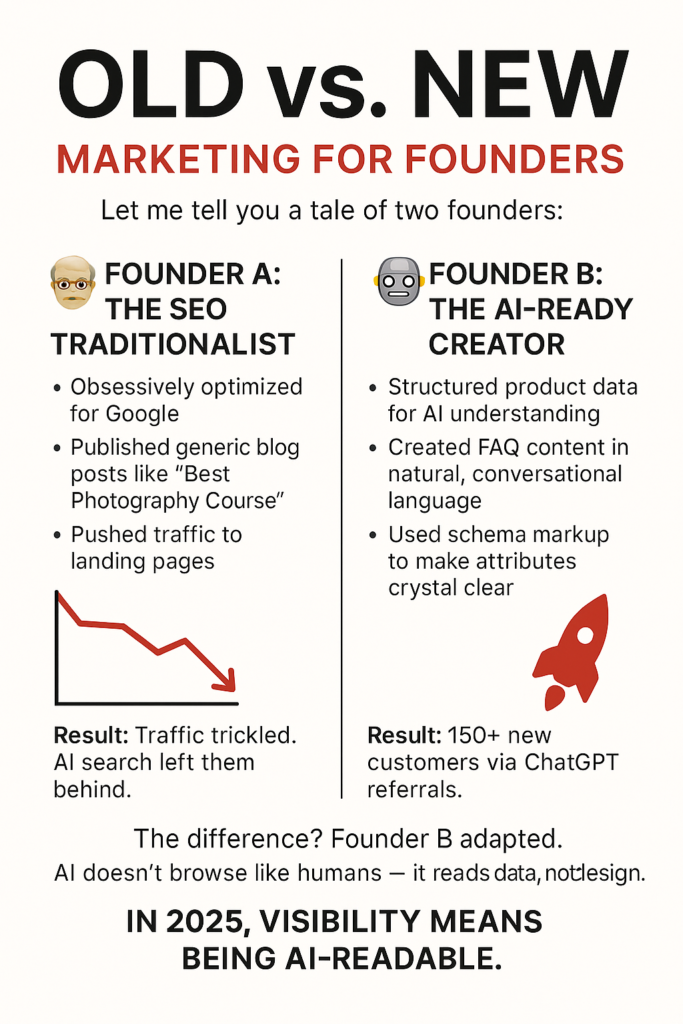
Let me share a tale of two digital product founders I’ve observed:
Founder A (The SEO Traditionalist):
- Spent months optimizing for Google keywords
- Created generic blog content for “best photography course”
- Focused on driving traffic to landing pages
- Result: Steady decline in discovery as AI shopping grows
Founder B (The AI-Ready Creator):
- Structured product data for AI comprehension
- Created conversational FAQs that match how people actually ask questions
- Built schema markup that clearly defines product attributes
- Result: 150+ new customers directly from ChatGPT referrals
The difference? Founder B understood that AI doesn’t “see” your landing page the same way humans do. It needs structured data that clearly communicates what your digital product does, who it’s for, and why it matters.
Key Differences Between Optimizing for Google and ChatGPT
As AI-powered platforms like ChatGPT change how users discover products, the rules of visibility are shifting.
Founders can no longer rely solely on traditional SEO tactics.
Here’s how optimizing for Google compares to optimizing for ChatGPT—and what you need to know to stay relevant.
| FEATURE | Ranking for Google | Ranking for ChatGPT |
| Ranking Approach | Algorithm-based ranking of websites | Curated answers based on vast knowledge base |
| Data Sources | Crawling and indexing the live web | Pre-trained data, potentially supplemented by Bing search |
Key Ranking Factors | Keywords, backlinks, technical SEO, E-E-A-T, user signals | Content quality, brand mentions, relevance, authority, E-E-A-T |
Optimization Focus | Website visibility in search results | Being included as a source in AI-generated answers |
Keyword Strategy | Targeting specific keywords for search queries | Understanding user intent through natural language prompts |
| Backlinks | Crucial for authority and ranking | Less direct impact; brand mentions more significant |
| Real-time Data | Considers real-time web data and trends | Relies on training data, may have some access to recent info via Bing |
| Paid Advertising | Direct impact on ad placements | No direct influence on organic responses |
The 5-Step Action Plan for Digital Product Creators
Ready to ensure your software, course, template, or other digital download thrives in the AI shopping era? Here’s your roadmap:
1. Optimize Your Metadata for AI Comprehension
AI doesn’t browse — it analyzes. Make sure your product information is crystal clear:
- Feature Lists: Replace marketing fluff with concrete capabilities
- Use Cases: Clearly define who uses your product and how
- Technical Specs: Format compatibility, size, requirements
- Updates: Version history and maintenance schedule
Remember: AI doesn’t care about your clever marketing copy. It wants facts it can match to user needs.
2. Implement Schema Markup
Schema.org provides standardized formats for describing products to machines. For digital products, focus on:
- SoftwareApplication markup for apps, tools, and programs
- Course markup for educational content
- Product markup for templates, assets, and other downloadables
This structured data tells AI exactly what your product is, allowing for precise matching to user queries.
3. Create Conversational Content
ChatGPT shopping relies on matching conversational queries to products. Build content that matches how people actually ask questions:
Instead of: “Top Features of Our Design Software”
Create: “What makes our design software perfect for beginners?”
Instead of: “Product Specifications”
Create: “How long does it take to learn our software?”
This conversational approach helps AI understand exactly when to recommend your product.
4. Build Trust Signals AI Can Read
AI prioritizes products with strong trust indicators. Make yours machine-readable:
- Structured Reviews: Implement proper review markup
- Transparent Pricing: Clear tiers with no hidden costs
- Support Options: Clearly defined help channels
- Update Frequency: Regular maintenance schedules
These signals help AI determine if your product is reliable and worth recommending.

5. Monitor AI-Specific Performance
Traditional analytics won’t capture AI-driven discovery. Track:
- Referrals from AI platforms
- Queries that lead to your product
- Competitive positioning in AI recommendations
- Conversion rates from AI referrals
This data helps you continuously optimize for AI shopping visibility.
The Deeper Truth: This Is Just the Beginning
The shift to conversational commerce isn’t just another marketing channel — it’s a fundamental change in how people find and evaluate products.
When people ask an AI for recommendations, they’re expressing direct buying intent at the exact moment they need a solution. Being visible at this critical moment is worth 10x more than being found through traditional search.
And unlike SEO, which can take months to show results, optimizing for AI shopping can deliver immediate visibility if done correctly.
Real-World Examples: Digital Products Already Winning
Some forward-thinking digital product creators are already positioning for AI shopping success:
Example 1: Software Template Creator
- Before: Generic product pages with basic feature lists
- After: Implemented SoftwareApplication schema with detailed compatibility info and use case scenarios
- Result: 47% increase in direct sales attributed to AI referrals
Example 2: Online Course Developer
- Before: Standard course landing page
- After: Added structured FAQ content matching common student questions
- Result: 112 new students in first month after optimization
Example 3: Productivity App Developer
- Before: Feature-focused website with technical specifications
- After: Created conversation-ready product descriptions and comparison data
- Result: Consistently recommended by ChatGPT for specific user scenarios
Beyond Visibility: The New Shopping Journey
Understanding the new user journey is crucial:
- Discovery: Users ask ChatGPT about solving a specific problem
- Comparison: ChatGPT presents options based on structured data
- Evaluation: Users ask follow-up questions to narrow choices
- Decision: ChatGPT links to the most relevant product
- Purchase: Transaction happens on the creator’s site
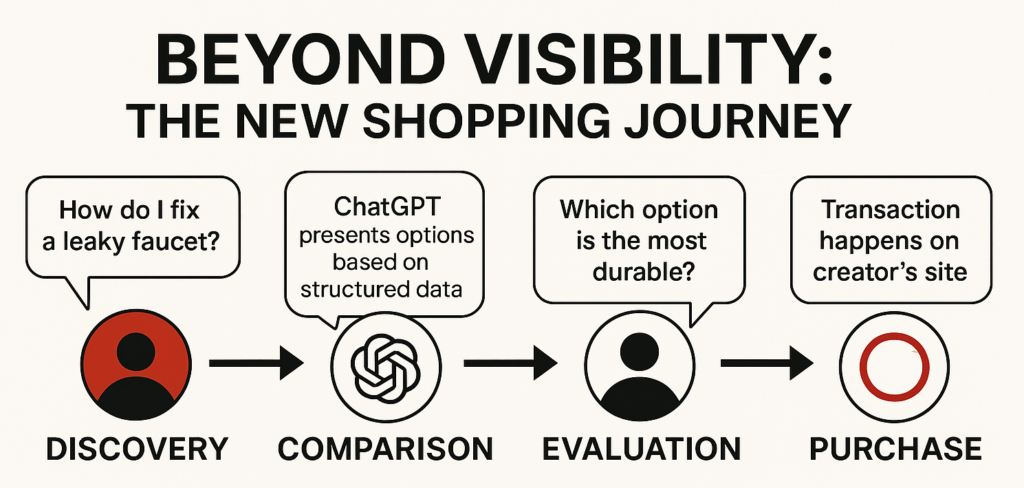
This streamlined process collapses what used to be days of research into minutes of conversation.
Three Strategic Questions Every Digital Product Creator Must Answer
As you prepare your products for AI shopping, answer these critical questions:
- What precise queries should trigger your product recommendation? Make a list of 10-15 specific questions that should lead to your product.
- What unique attributes differentiate your product from alternatives? Identify 3-5 key factors that set your digital product apart.
- What trust signals will convince the AI your product is reliable? Determine how to demonstrate quality and reliability in structured data.
These answers form the foundation of your AI shopping optimization strategy.
The Imminent Timeline: Why You Need to Act Now
While digital products aren’t yet included in ChatGPT’s shopping features, the timeline for expansion is accelerating:
- Current Stage (May 2025): Physical product shopping live in ChatGPT
- Next 3-6 Months: Expansion to additional product categories
- 6-12 Months: Digital products fully integrated into AI shopping
Creators who optimize now will have first-mover advantage when digital product shopping goes live.
Your Next Steps: The Practical Roadmap to Ranking on ChatGPT
Here’s your actionable plan for the next 30 days:
Week 1: Audit & Research
- Identify how users naturally ask about your product category
- Analyze your current product data structure
- Document key product attributes and differentiators
Week 2: Technical Optimization
- Implement appropriate schema markup
- Structure product data for AI readability
- Create conversational FAQs matching user queries
Week 3: Content Enhancement
- Develop detailed use case scenarios
- Create comparison content with alternatives
- Build structured review systems
Week 4: Testing & Refinement
- Test how ChatGPT currently describes your product
- Refine based on actual AI responses
- Develop tracking for AI-driven referrals
By executing this plan, you’ll be positioned to capture the first wave of AI shopping traffic for digital products.
The Ranking Opportunity Hidden in Plain Sight
While most digital product creators are still focused solely on SEO, social media, and paid ads, a massive opportunity is emerging for those who understand conversational commerce.
The shift to AI shopping isn’t just another marketing channel — it’s a fundamental transformation in how people discover and choose products. Preparing now isn’t just about staying current; it’s about securing your place in the next generation of digital commerce.
Remember: Your next 1,000 customers won’t find you through Google searches. They’ll discover you through conversations with AI. The question is whether you’ll be ready when they ask.
Schedule a 15-min visibility audit to get your brand GPT ready.

